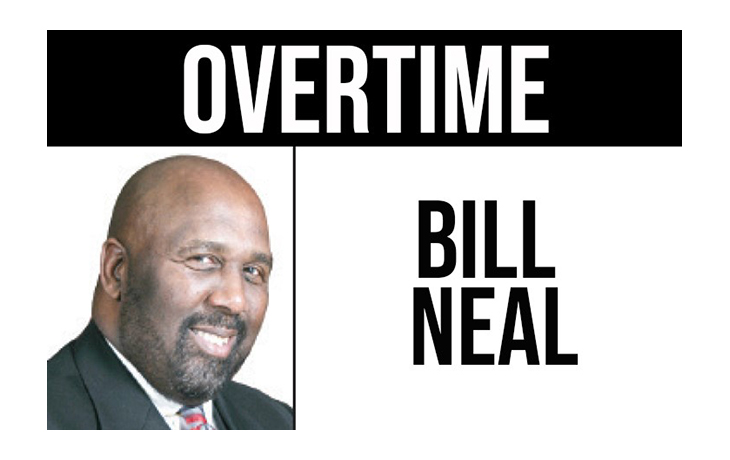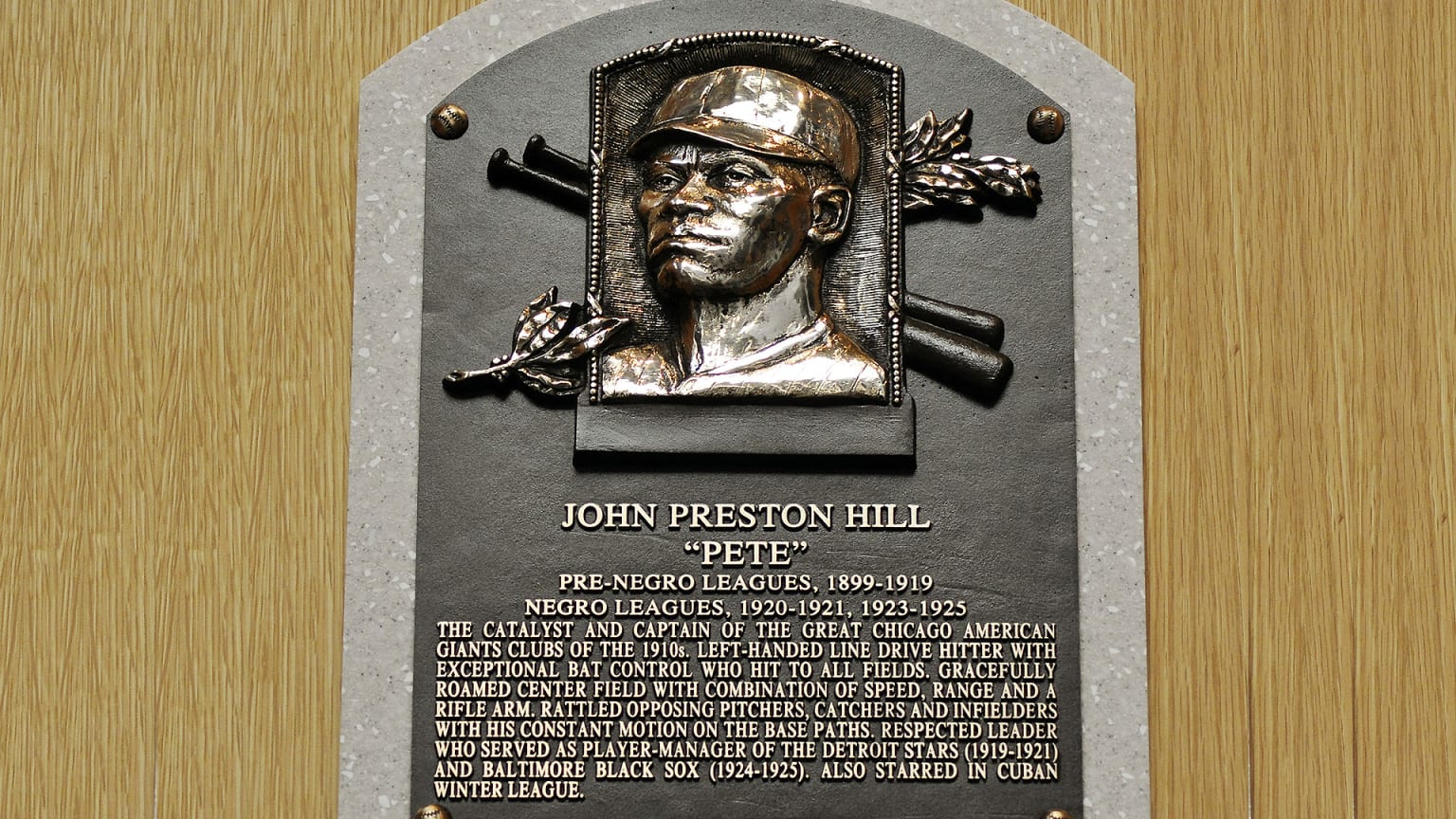RONALD HILL, great nephew of Pete Hill, chats with National Baseball Hall of Fame and Museum former president Jeff Idelson during a plaque rededication ceremony in 2010. (Photo courtesy mlb.com)
Chicago Defender said Hill ‘helped put Negro baseball on the map’
(Editor’s note: This column goes out to Ron Hill, the great-nephew of John Preston “Pete Hill.” Ron Hill is a former great athlete and football player at Westinghouse High School, and Pittsburgh City League Hall of Famer. He’s also a longtime community and entertainment leader.”)
True enough, it’s spring again. Birds are flying, flowers are blooming, yada, yada, yada…but rather than ruining your early spring and summer “get up and go,” talking about the Pittsburgh Pirates, I am going to treat you to the last part of my Black history tribute partnered with the upcoming baseball season minus your Pittsburgh Pirates. There’ll be plenty of time for that.
This is a tribute and celebration for John Preston “Pete” Hill. A former Negro League Baseball player and manager for the Negro Leagues. Hill was born on October 12, 1882 in Buena, Culpeper County, Virginia, to Ruben Hill and Elizabeth Seals, both likely previously enslaved.
Banned from the Whites-only Major Leagues, Hill became a star outfielder for Negro League teams the Philadelphia Giants and the Chicago American Giants. A stint in the 1910-11 Cuban League earned him a batting championship with a .365 average. As a power hitter, Hill hit 28 home runs in 1919, at the same time Babe Ruth hit 29 (but in more games).
Hill retired from pro ball in 1925 at age 43 and lived his life out in Buffalo, New York. Hill died in 1951 and is buried in Alsop, Illinois.
The original “Pistol Pete” was inducted into the National Baseball Hall of Fame in 2006. He was the first African American to have his portrait displayed in the Culpeper County Circuit Court.

The following detailed information is compliments of and provided by historian Ms. Zann Nelson: “In July of 2006, a man named Joseph Preston ‘Pete’ Hill, born in Pittsburgh, Pa., in 1880, was inducted into the Baseball Hall of Fame in Cooperstown, N.Y. Among numerous accolades, Pete was called, ‘one of the greatest line-drive hitters of his era.’ Despite an extraordinary career, spanning a quarter of a century playing ball in the Negro Leagues as an outfielder, Pete’s induction lacked fanfare and the expected ‘hometown hero’ press.”
There are a lot of halls of fame, but none as prestigious as Cooperstown. Having one’s bronzed image and accompanying stats selected for inclusion alongside other baseball greats is truly the accomplishment of a lifetime, the Pulitzer Prize of baseball.
As with many players, the selection was made long after Pete’s death in 1951, nonetheless, there was a distinct absence of fans. More importantly, there was not a single chest pounding, proud-as-punch family member present. His induction ceremony was witnessed only by strangers present to share the glory of some other inductee. The few diehard aficionados who recognized his achievements, despite knowing little of his personal life, were more than a little puzzled and began to ask questions.

Their research was extremely thorough and led to a remarkable discovery: the man inducted in 2006, indeed was “Pete” Hill, but his real name was John, not Joseph, his birthdate was not 1880 and he was not born in Pittsburgh.
Brad Horn Sr., director, communications and education, National Baseball Hall of Fame and Museum, commented, “As a historical institution, providing the most accurate information is paramount to our responsibility as an education center.”
States and local communities lust after the claim to a world-class baseball player. Virginia officially claims only four of the 289 baseball Hall of Famers, hailing from Remington, Culpeper, Richmond and Norfolk.
By the summer of 2009, exhaustive research suggested that Pete Hill would become Virginia’s fifth baseball Hall-of-Famer and Culpeper County just might be able to claim a second member of the hallowed hall.
The question: Was “Pete” Hill born in Culpeper County, Virginia?
The challenge: If so, can it be proven?
Zann Nelson accepted the challenge and the ensuing four to six months were filled with days of Internet and court records searches, field surveys, and extensive discussions with baseball historians, local residents and family members. The quest for the story of baseball great, “Pete” Hill and his Rapidan, Virginia, roots continues, but it is no cakewalk.
“There may be no one who wants to find after I am dead and gone, but just on the slim chance that someone might, I am going to write down the important facts and record it in my will,” Nelson said. “I will be certain to include the accurate spelling of my name and all possible variations, the names and birthdates of my children, the same data for my parents and siblings, where I lived and when and where I at least request to be buried.”
After learning that two of Pete’s aunts listed their birthplace as Orange on their marriage records, Nelson could hardly get to the Orange County Courthouse fast enough. All the missing links would be connected once she reviewed the records. Finally, the mysteries of Pete’s birthdate, birthplace and mother’s family would be solved.
“I parked the car, arrived on the third floor, headed to the back room and buried myself with anticipatory glee in the birth, death and marriage records,” Nelson said. “Oh, my gosh, nothing! I could not believe it; there were no Seals, Seales, or any other comparable spelling. In all my dismay, there was still a glimmer that I had missed something.”
Nelson eventually came across the birth of two girls of the same age as two of Pete’s aunts, listed as colored and whose parents were identified by the same given names as Pete’s grandparents. But the surname was way off. Despite her skepticism, Nelson wrote down the info and left.
Later that evening, feeling pretty bummed out, “I decided to run the name through the Internet search file. I haven’t mentioned the name before now because it is so farfetched. The name was Seigles, German and nothing like Seal, but I plugged it in any way along with the location of Orange County.”
And that’s when Nelson hit the jackpot. “There they were in the 1880 Census, the whole darn family, Pete’s mother’s family that is. The same information steered me to find them in the 1870 Census living at the same location. The living descendants now have additional ancestors —Pete’s mother’s siblings, ages, occupations and the possibility of locating their 1870-80 residence. But, on which side of the Rapidan River was Pete born? The fact is yet to be confirmed. I have a theory, but it must wait for more sleuthing and another column.”